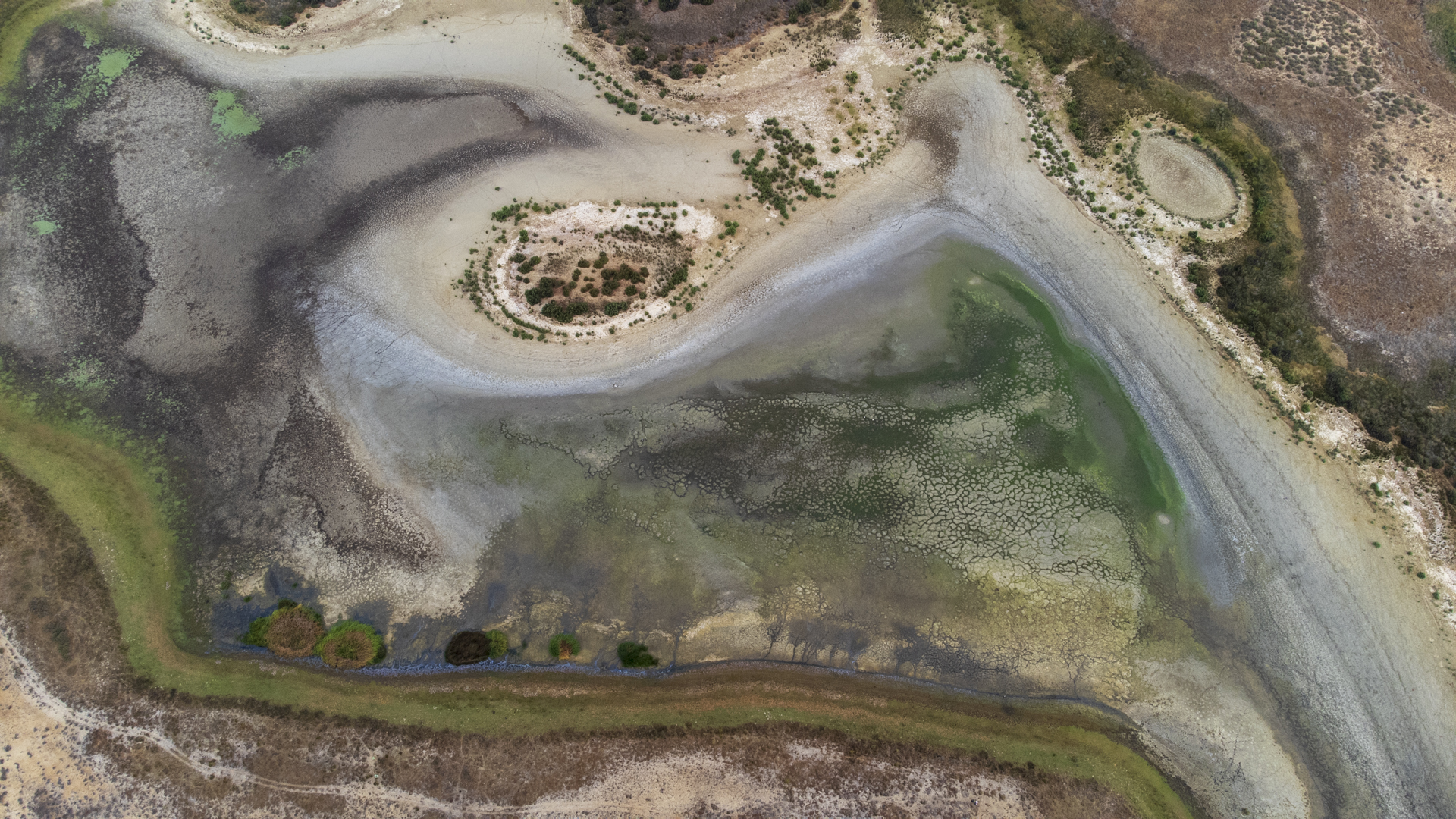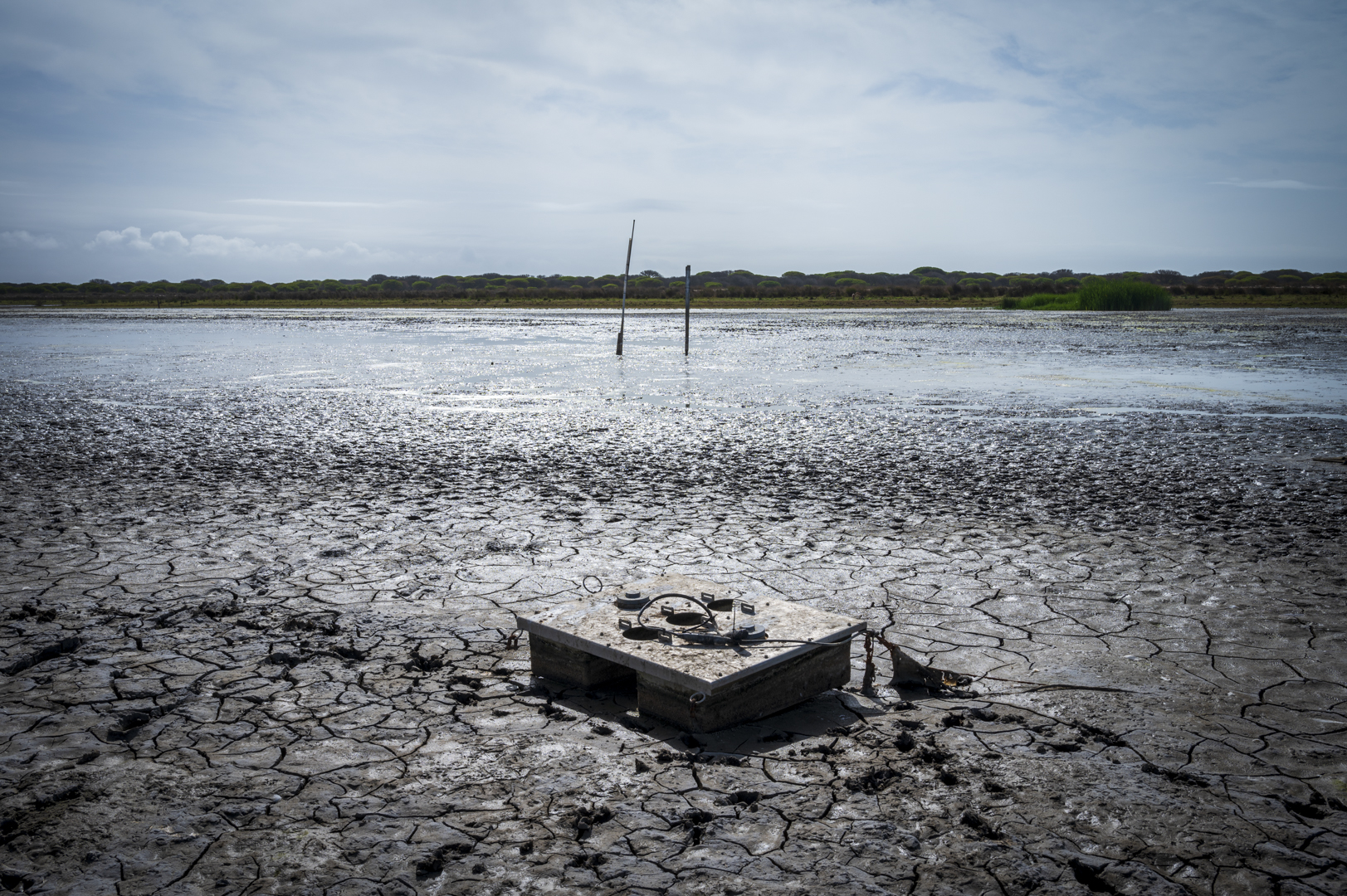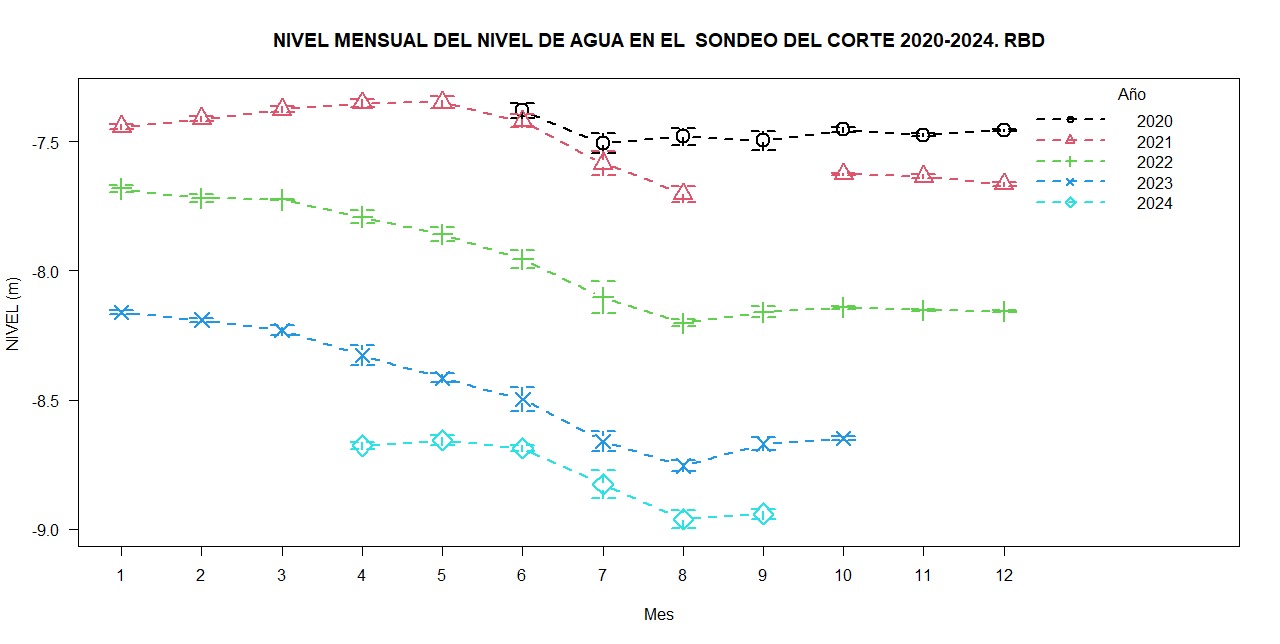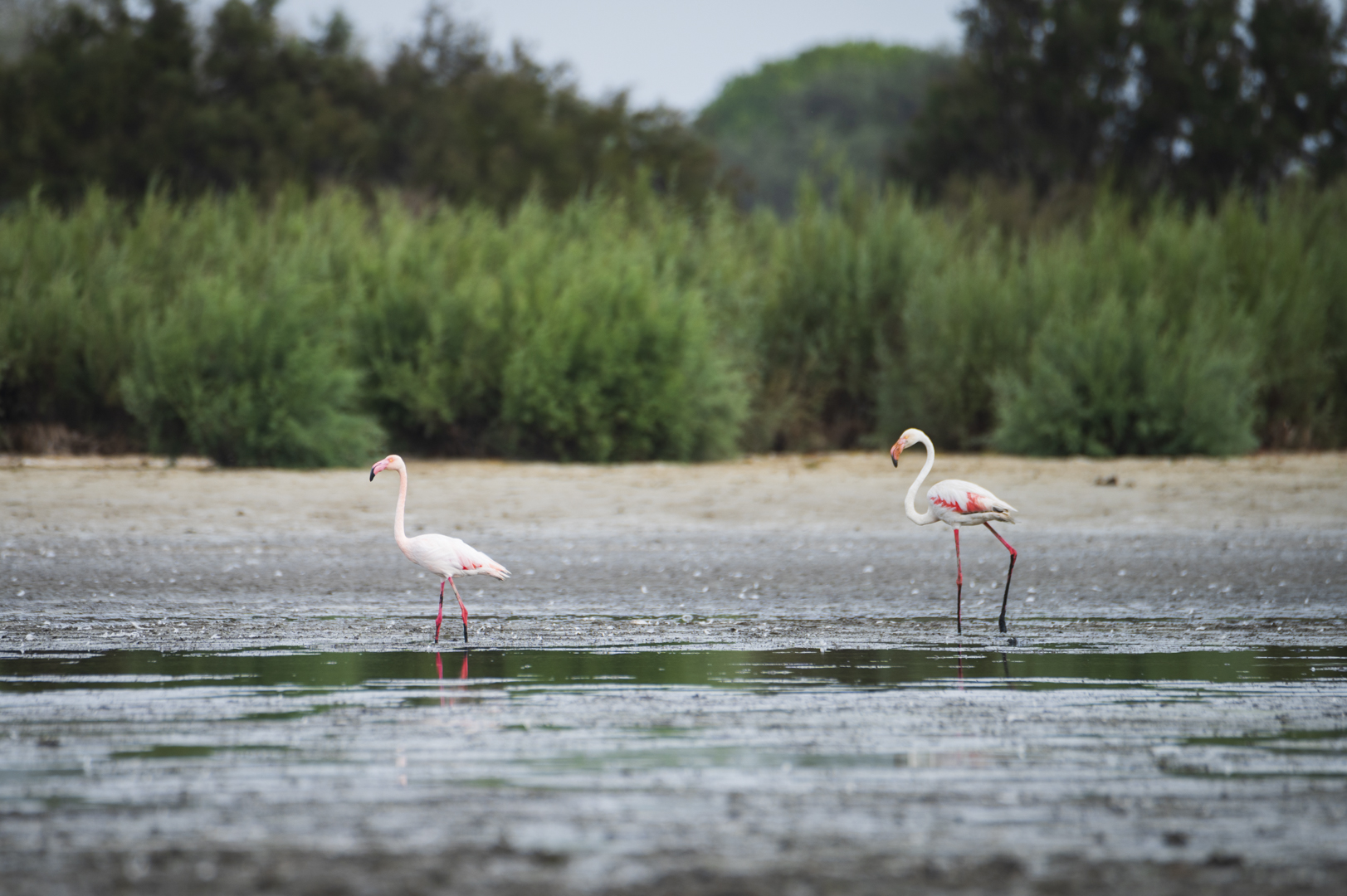Doñana loses its last permanent pond: Santa Olalla dries up for the third year in a row
La Dulce, also considered a permanent pond until recently, has dried out completely

Santa Olalla, the largest pond in the Natural Area of Doñana, in Andalusia (Spain) is in a critical situation at the end of the summer, practically dry with only a surface layer of residual moisture and mud, according to the warnings of the Doñana Biological Station (EBD) of the Spanish National Research Council (CSIC), an agency of the Spanish Ministry of Science, Innovation and Universities.
This pond, the largest in Doñana, dried up completely for two years in a row, in the summers of 2022 and 2023, a situation never registered since the EBD-CSIC started to monitor the natural space 50 years ago. “Doñana is going through very tough years. The combination of the overexploitation of the aquifer and an intense and prolonged drought are having a great effect on the pond system of the protected area”, explains Eloy Revilla, director of the EBD-CSIC.
The Santa Olalla pond was almost the only one of the more than 3,000 ponds in Doñana that used to hold water all year round. The diversity of lagoons, both temporary and permanent, makes it possible to conserve species with different reproductive and development cycles, shorter or longer, which makes Doñana an incomparable refuge for aquatic biodiversity. However, in the summer of 2022, Santa Olalla dried up completely just at the end of the annual hydrological cycle, which is timed from September to August. The situation was similar the following year, and by the second week of August 2023, Doñana's largest pond had no water left.
‘Therefore, the hydrological cycle that has just closed began in September 2023 with a completely dry Santa Olalla. The situation continued for two continuous months until the first rains in mid-October helped the aquifer level to rise and the water began to flood the lagoon basin. The maximum flooding was finally reached at the end of February,’ says Javier Bustamante, also from the EBD-CSIC.

The effects of high temperatures
From April onwards, the ICTS Doñana sensors detected a large proliferation of filamentous algae due to a high proportion of nutrients, favoured by the high temperatures and the low mobility of the water. Satellite images analysed by the team of the Laboratory of GIS and Remote Sensing of the EBD-CSIC confirmed that they were located around the shore. The highest peak was detected at the end of June, with more than 280,000 cyanobacterial cells per millilitre. Although not all are toxic, numbers above 100,000 cells/ml are considered excessive, as it may increase the likelihood of toxicity to other organisms such as birds or fish.
Later, during July, due to rising temperatures and the progressive decrease of the flooded surface, there was a large phytoplankton bloom that spread over the entire surface of the lagoon. The highest values were detected on 31 July, with just over 140,000 cells per millilitre. It was also observed, as every year, how the salinity values of the lagoon increased as the summer progressed due to the effect of water evaporation and the loss of flooded surface, from 6.6 grams per litre at the beginning of June to 13.6 at the end of July.
For some days now, the ICTS Doñana Environmental Monitoring team, which is responsible for monitoring biodiversity and natural processes in the protected area, has been unable to take representative samples of water for analysis, as only residual humidity and mud remain. To observe the situation of the pond in real time, the ICTS Doñana has installed a camera on the shore of the lagoon that can be accessed publicly through this website.
La Dulce pond, located very close to Santa Olalla and until a few years ago also considered a permanent pond, dried up completely during the second week of September, a little over a month later than last year, when it dried up at the beginning of August. The Hondón pond, on the other hand, has maintained water throughout the summer.

The functioning of the pond system in Doñana
The Santa Olalla pond, as well as all the ponds in the National Park, which are located in the area close to the dunes, are flooded thanks to discharges from the aquifer, so their flooding cycles depend on the groundwater levels. When it rains, the water seeps into the aquifer, causing the water table to rise and even to reach the surface, flooding the pond basins. In addition, Santa Olalla also receives water from the dunes.
Recent studies by the EBD-CSIC have shown that 60% of the ponds that existed in the 1980s have already disappeared. In addition, many of those that still remain are flooded much less and for a shorter period of time than expected due to the climate, indicating that direct human action is interfering with their natural cycle.
‘This was confirmed when the research team observed that this phenomenon most affected the ponds closest to the intensively irrigated crops and the tourist resort of Matalascañas. Furthermore, a large part of the ponds that still exist have part of their basin invaded by terrestrial vegetation, which indicates a change with no return,’ Revilla points out.
Bustamante explains: ‘Santa Olalla has already lost a large part of its former extension and for some years now aerial images have shown that its current shores and its central island are being invaded by tamarisk and other types of terrestrial vegetation’.
In the Doñana National Park, there are piezometers distributed throughout the area to measure the water table of the aquifer. Specifically, the piezometer located closest to Matalascañas, the one at El Corte, just 300 metres from the disappeared Charco del Toro lagoon and about three kilometres from Santa Olalla, has shown a very pronounced drop over the last few years.

‘About four years ago, in 2020, the depth of the water table at this point was about 7.5 metres. In 2024, it has dropped to a depth of nine metres, something that had never been seen before’, says Revilla.
Scientists warn that this situation is worsening in recent years due to drought. Doñana has had below-average rainfall for more than ten years. The 2021-2022 and 2022-2023 cycles were classified as ‘very dry’, with accumulated rainfall of only 282.5 millimetres in the first case and 330.4 millimetres in the second. This cycle, which has just ended, accumulated 434.4 millimetres of rainfall, not reaching either the average of around 500 millimetres.

Impacts on the biodiversity
Studies by the Doñana Biological Station show that the deterioration of the lagoon system is having a major impact on the fauna and flora of Doñana, in particular on its particularly vulnerable community of amphibians and aquatic reptiles. In recent research, current data on 11 amphibian species were compared with those collected 18 years ago. While all species could still be found in Doñana, their presence had generally declined. In addition, until recently, the protected area maintained good populations of the two native turtles, the European pond turtle and the leper, but these are now on the verge of disappearing.
The monitoring work carried out by the ICTS Doñana in Doñana generates decisive information for management and conservation measures in one of the most important biodiversity reserves in Europe. Doñana is also an excellent natural laboratory for research into the ecology, evolution and conservation of biological diversity and the impact of global change. To this end, the data collected by the ICTS-Doñana are openly available on the website https://icts-donana.es/ and, at the request of the scientific community, on the website https://solicitudes.icts.ebd.csic.es/ .
